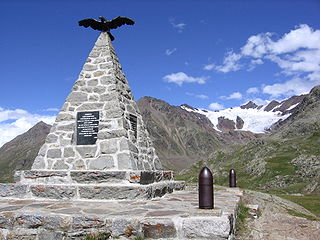 W
WThis article is about Italian military operations in World War I.
 W
WThe Armistice of Villa Giusti ended warfare between Italy and Austria-Hungary on the Italian Front during World War I. The armistice was signed on 3 November 1918 in the Villa Giusti, outside Padua in the Veneto, Northern Italy, and took effect 24 hours later.
 W
WThe Battle of San Matteo took place in the late summer of 1918 on the Punta San Matteo during World War I. It was regarded as the highest battle in history until it was surpassed in 1999 by the Kargil Conflict at 5,600 m.
 W
WThe Bollettino della Vittoria is the official document after the Armistice of Villa Giusti with which General Armando Diaz, the supreme commander of the Royal Italian Army, announced, on November 4, 1918, the surrender of the Austro-Hungarian Empire and the victory of the Kingdom of Italy in World War I.
 W
WThe Bollettino della Vittoria Navale is the official document written after the armistice of Villa Giusti with which the admiral Paolo Thaon di Revel, supreme commander of the Royal Italian Navy, announced, on 12 November 1918, the surrender on the seas of the Austro-Hungarian Empire and Italy's victory in the World War I.
 W
WThe Flight over Vienna was an air raid during World War I undertaken by Italian poet and nationalist Gabriele D'Annunzio on 9 August 1918. With 11 Ansaldo S.V.A. from his team, the 87ma squadriglia (squadron) called La Serenissima all bearing the Lion of St Mark painted on their fuselage sides as the squadron's insignia, he flew for over 1,200 km in a round trip from the squadron's military airfield in Due Carrare to Vienna to drop thousands of propaganda leaflets.
 W
WThe Second Battle of the Piave River, fought between 15 and 23 June 1918, was a decisive victory for the Italian Army against the Austro-Hungarian Empire during World War I. Though the battle proved to be a decisive blow to the Austro-Hungarian Empire and by extension the Central Powers, its full significance was not initially appreciated in Italy. Yet Erich Ludendorff, on hearing the news, is reported to have said he 'had the sensation of defeat for the first time'. It would later become clear that the battle was in fact the beginning of the end of the Austro-Hungarian Empire.
 W
WIn 1918–1920, a series of violent fights took place in the city of Split between Croats and Italians, culminating in a struggle on 11 July 1920 that resulted in the deaths of Captain Tommaso Gulli of the Italian protected cruiser Puglia, Croat civilian Matej Miš, and Italian sailor Aldo Rossi. The incidents were the cause of the destruction in Trieste of the Slovenian Cultural Centre by Italian Fascists.
 W
WThe Battle of Vittorio Veneto was fought from 24 October to 3 November 1918 near Vittorio Veneto on the Italian Front during World War I. The Italian victory marked the end of the war on the Italian Front, secured the dissolution of the Austro-Hungarian Empire and contributed to the end of the First World War just one week later. The battle led to the capture of 5,000+ artillery pieces and over 350,000 Austro-Hungarian troops, including 120,000 Germans, 83,000 Czechs and Slovaks, 60,000 South Slavs, 40,000 Poles, several tens of thousands of Romanians and Ukrainians, and 7,000 Italians and Friulians.